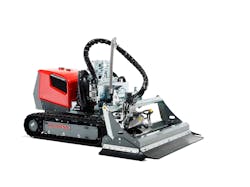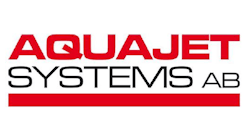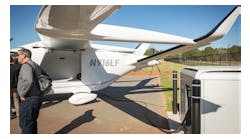Aquajet Systems AB offers a small hydrodemolition robot, the Aqua Cutter 410V. The model combines the compact size of the Aqua Cutter 410A and the mast system of the Aqua Cutter 710V, giving it versatility to work in tight spaces with extended reach in horizontal, vertical and overhead applications. The 410V’s design makes it suitable for a wide variety of concrete removal tasks, such as renovation and bridge and road repair.
“We provide contractors the ability to work in confined spaces while improving safety and productivity,” said Roger Simonsson, Aquajet Systems managing director. “The Aqua Cutter 410V accomplishes that and more. This means less risk for contractors, higher ROI and more successful jobsites.”
The 2,756-pound (1,250-kilogram) Aqua Cutter 410V uses 15,000- to 40,000-psi water jets to remove as much as 9 cubic feet (.25 cubic meters) per hour of concrete. Contractors adjust the robot’s stroke to control the depth of cuts and vary the water pressure depending on whether they are removing loose, deteriorated concrete from the sound concrete below, or sound concrete to a pre-determined depth. The process has the added benefit of cleaning and descaling the rebar. Operators can control the 410V from a safe distance using the unit’s radio remote control, either wirelessly or with a hard wire. The remote communicates with the robot’s wheeled power control module. Contractors can remove the module from the tracked portion to reduce the crawler to a third of its original size and create an even more compact robot. This provides the ability to drive the crawler into tight and inhospitable environments, such as small tunnels and flooded sewer pipes, while the module remains connected via a cord.
In addition, the 410V easily removes concrete in corners that would be difficult to access with hand tools. Its small size and light footprint allow operators to use the unit in confined areas — including passing through narrow passages, such as doorframes or operating from scaffoldings — while retaining full mobility.
Contractors use Aquajet’s unique cutting head and its multi axis 3D positioning system to efficiently operate on all horizontal, vertical and overhead areas. This includes straight up and down work, such as demolishing walls, shafts and furnaces. Aquajet constructs the 410V’s steel mast in sections — an innovative design that gives the operator freedom to raise the front power head up to 13.2 feet (4 meters) without additional support.
Aqua Cutter robots feature unique ceramic nozzles specifically designed for demanding hydrodemolition applications. The highly-efficient nozzles last 300-350 hours, depending on the water quality. In comparison, standard steel nozzles used on competitive equipment last 20-40 hours.
All Aqua Cutter robots feature Aquajet Systems’ patented Equal Distance System. EDS maintains a preset distance from the nozzle to the concrete surface, regardless of the angle of the water jet, allowing for maximum efficiency and productivity. Systems without EDS lose as much as 20 percent of the power before the water hits the concrete, greatly reducing productivity and increasing waste.
The 410V robot fits into Aquajet Systems’ 23-foot Power Packs. These large metal containers include a high pressure Hammelmann pump, large capacity engine and control system, along with a storage area for the robot, making for easy transportation to and from the jobsite and a secure location for the duration of the job.
The hydrodemolition robot features unrivaled ease of access for all maintenance, allowing for minimal downtime. The foldable back cover of the Aqua Cutter robots offers total access for both daily jobs, such as checking oil levels, as well as periodic service jobs, such as oil and filter changes.
The 410V features electric power and is compatible with Aquajet Systems’ line of accessories, such as rotolances and circular power heads, as well as spines and frames. Contractors can also choose the Aqua Cutter 410V Tunnel Kit, specifically designed for tunneling work. The kit features automatic detection and the ability to adjust the distance to the tunnel surface. This makes it very easy to operate in uneven tunnel shapes or oval tunnels.



